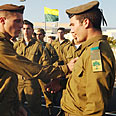
Golani Brigade soldiers (archive photo)
צילום: דובר צה"ל
The 'Ashkenazi Effect'? Draftees go for Golani Brigade
IDF satisfied with March induction for combat units, which begins Sunday morning. About 70 percent of combat-fit draftees seek to serve in field units. Interest in the Golani Brigade has skyrocketed – 2.7 draftees are competing for each open space
It seems that the appointment of IDF Chief of Staff Gabi Ashkenazi, who served in the Golani Brigade, has had an effect on the IDF’s newest draftees. In the previous round of inductions 1.9 solders competed for each open space in the infantry unit, whereas 2.7 draftees are now in the running for each spot, according to statistics from the March 2007 induction, which begins Sunday.
Of the draftees with a combat-level medical profile, 69.5 percent requested to serve in field units, a slight drop since more than 70 percent sought to serve in the field in the post-war November induction, but up by 0.7 percent since the pre-war induction of March 2006.
A senior officer in the Human Resources Branch said, “Not only did the war not diminish motivation, it unified everyone and caused many more draftees to want to serve in combat units.” Upon their arrival at the Tel Hashomer Induction Center, those selected for service in Golani will undergo a process of induction, meet their officers and, after a night on the base, head off to begin basic training.
Second to Golani in demand is the Nahal Infantry Brigade. In this induction 2.3 candidates competed for each open space, up from 1.7 in the previous induction. The Givati Infantry Brigade registered a small rise in motivation since the last draft, with 1.1 candidates for each opening, whereas the new Kfir Brigade, a surprise last time with 1.1 candidates for each space, reached only 0.7 this time.
The IDF is facing staffing difficulties mainly in artillery and armored units, where inductees' motivation has never been particularly high. Armored units, which played a prominent role in the war of last summer, suffered a further drop in popularity and had only 0.3 requests for each open space.
Over the past few weeks officers have even been visiting draftees' homes in an effort to convince them to serve in these less-popular units. “In any case we don’t intend to lower standards, and everyone we need in the Armored and Artillery Corps will be there,” declared a high-ranking officer.
Integration of yeshiva students continues
The trend of integrating Hesder yeshiva students into regular units, where they serve alongside secular soldiers, is expected to continue, with four or five new “mixed” platoons planned. However, at least six all-Orthodox brigades, in which only Hesder yeshiva students serve, will remain intact.
In this induction several dozen women, who during their military service asked to be transferred to combat units, will begin basic training.
Most draftees fit for combat service will be assigned to the units they ranked either first or second on their request forms, whereas 30 percent will be sent to the unit they ranked third. All draftees received advance notification of the units in which they will serve.
Among the March draftees will be youths from Gush Katif who were involved in protests against the security forces during the Gaza withdrawal of 2005 and against whom criminal proceedings were opened. A senior officer emphasized that the draftees had either been acquitted or the cases against them had been closed and that there is thus no difference between them and other draftees.










